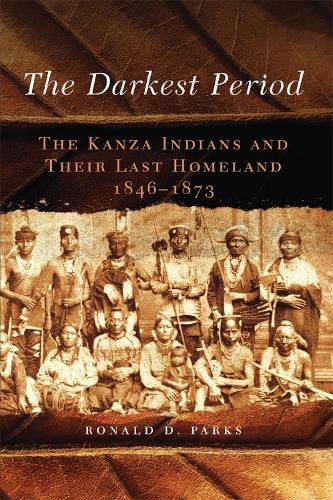Readings Newsletter
Become a Readings Member to make your shopping experience even easier.
Sign in or sign up for free!
You’re not far away from qualifying for FREE standard shipping within Australia
You’ve qualified for FREE standard shipping within Australia
The cart is loading…






Before their relocation to the Indian Territory in present-day Oklahoma, the Kanza Indians spent twenty-seven years on a reservation near Council Grove, Kansas, on the Santa Fe Trail. In The Darkest Period, Ronald D. Parks tells the story of those years of decline in Kanza history following the loss of the tribe’s original homeland in northeastern and central Kansas. Parks makes use of accounts by agents, missionaries, journalists, and ethnographers in crafting this tale. He addresses both the big picture - the effects of Manifest Destiny - and local particulars such as the devastating impact on the tribe of the Santa Fe Trail. The result is a story of human beings rather than historical abstractions.
The Kanzas confronted powerful Euro-American forces during their last years in Kansas. Government officials and their policies, Protestant educators, predatory economic interests, and a host of continent-wide events affected the tribe profoundly. As Anglo-Americans invaded the Kanza homeland, the prairie was plowed and game disappeared. The Kanzas’ holy sites were desecrated and the tribe was increasingly confined to the reservation. During this
darkest period,
as chief Allegawaho called it in 1871, the Kanzas’ Neosho reservation population diminished by more than 60 percent. As one survivor put it,
They died of a broken heart, they died of a broken spirit.
But despite this adversity, as Parks’s narrative portrays, the Kanza people continued their relationship with the land - its weather, plants, animals, water, and landforms.
Parks does not reduce the Kanzas’ story to one of hapless Indian victims traduced by the American government. For, while encroachment, disease, and environmental deterioration exerted enormous pressure on tribal cohesion, the Kanzas persisted in their struggle to exercise political autonomy while maintaining traditional social customs up to the time of removal in 1873 and beyond.
$9.00 standard shipping within Australia
FREE standard shipping within Australia for orders over $100.00
Express & International shipping calculated at checkout
Before their relocation to the Indian Territory in present-day Oklahoma, the Kanza Indians spent twenty-seven years on a reservation near Council Grove, Kansas, on the Santa Fe Trail. In The Darkest Period, Ronald D. Parks tells the story of those years of decline in Kanza history following the loss of the tribe’s original homeland in northeastern and central Kansas. Parks makes use of accounts by agents, missionaries, journalists, and ethnographers in crafting this tale. He addresses both the big picture - the effects of Manifest Destiny - and local particulars such as the devastating impact on the tribe of the Santa Fe Trail. The result is a story of human beings rather than historical abstractions.
The Kanzas confronted powerful Euro-American forces during their last years in Kansas. Government officials and their policies, Protestant educators, predatory economic interests, and a host of continent-wide events affected the tribe profoundly. As Anglo-Americans invaded the Kanza homeland, the prairie was plowed and game disappeared. The Kanzas’ holy sites were desecrated and the tribe was increasingly confined to the reservation. During this
darkest period,
as chief Allegawaho called it in 1871, the Kanzas’ Neosho reservation population diminished by more than 60 percent. As one survivor put it,
They died of a broken heart, they died of a broken spirit.
But despite this adversity, as Parks’s narrative portrays, the Kanza people continued their relationship with the land - its weather, plants, animals, water, and landforms.
Parks does not reduce the Kanzas’ story to one of hapless Indian victims traduced by the American government. For, while encroachment, disease, and environmental deterioration exerted enormous pressure on tribal cohesion, the Kanzas persisted in their struggle to exercise political autonomy while maintaining traditional social customs up to the time of removal in 1873 and beyond.